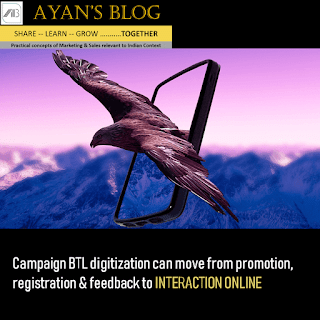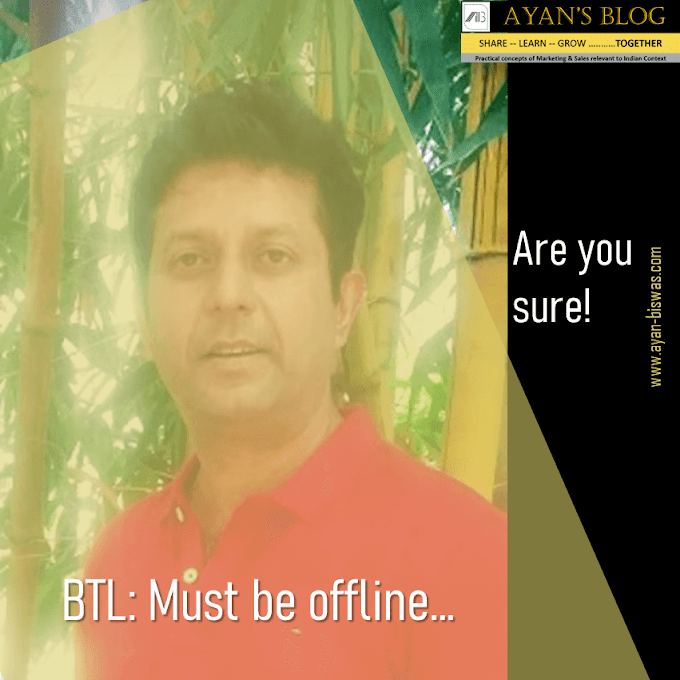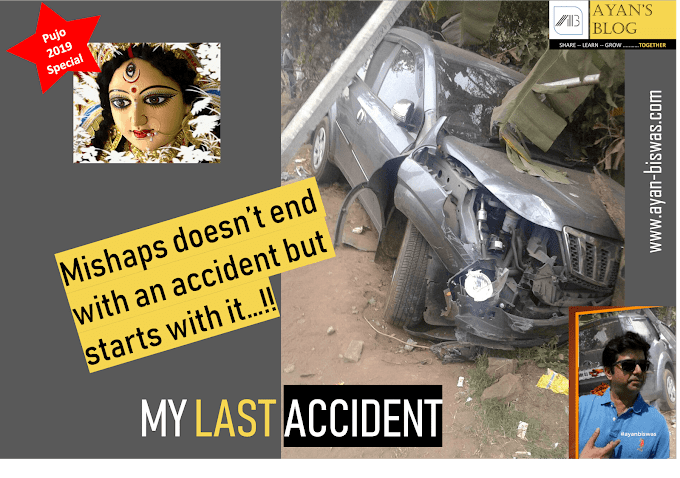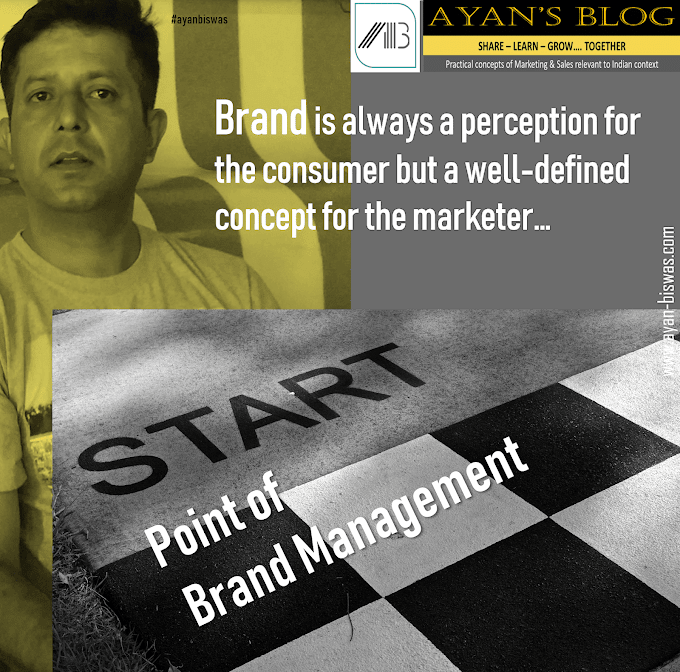 |
| Why BTL Marketing has to be always Offline? |
What is a “Line” doing in
marketing...??
Just take
your geometry book out & check yourself (😉), or give
your own definition, like a “line is a dot on a walk” 😂.
We all know it’s a mathematical term, but what is it doing in marketing 😯
 |
| What is a line doing in Marketing |
Line in
marketing.???.... Well, it’s very much there…. u forgot...!!.... ABOVE-THE-LINE/THROUGH-THE-LINE/BELOW-THE-LINE…. ATL/TTL/BTL...!!...So, now we all know line
is a mathematical term used in marketing...!! If “Line” is a mathematical term,
then it must be very well defined…right like all other mathematical terms, so
let me ask you a couple of questions
Q1. in ATL/TTL/BTL….
why is the line required??
Q2. In ATL/TTL/BTL…where
is the line??
Stumped...!!so
was I when I first asked this question to myself. Let’s get back to the history
to answer it.
First &
Foremost, to start off there was no term as TTL (Through-the-line), it’s more
of “Fill-in-the-blanks”. So initially 2 terms first came together ATL &
BTL, courtesy P&G. The reason, you will be surprised was not
marketing-driven, but cost driven 😮, although the basis
for the division was marketing.
Way back in
1954, agencies (primarily advertising agencies) were paid on the same platform
whether they used mass-media or direct-marketing approach. P&G wanted to
pay those two types of approaches @ a different rate & also earmark those
two types of agencies differently. Hence, for the advertising agencies with
mass-media they called ATL & that with a direct-marketing they called BTL. Hence
the origin. This means the ATL & BTL division was primarily based on the “way
marketing reached to consumers”, which till date holds good. So, anything above
the line is called ATL & anything below the line is called BTL. Later,
companies found alone one is not enough, they need to do both together i.e. ATL
& BTL keeping the message to the target audience same…hence came the
concept of IMC (Integrated marketing communication) which is also called (but
less used) TTL (through the line), as it’s a mix of both ATL & BTL. So,
this broadly answers the first question, why the line is required…
Line is
required primarily to distinguish between the different “way marketing reached
to consumers” & accordingly design the back-end of marketing campaigns
& also accordingly pay the respective type of marketing agencies.
Now comes
the second question…. where is the line…well it gets a bit tricky here😃? Let’s look @ the definition to understand it…ATL refers to
addressing “mass-consumers”. Over a period “mass-marketing” has been termed as
“mass-media” because you address “mass-consumers” by “mass-media”. This means
all media vehicles which address mass becomes ATL, hence TV, Radio, print etc.
etc. becomes ATL. This change of definition due to “convenience” has created
the confusion.
Let’s go
back to the basic & ask the fundamental question is what is “mass-consumer”??...for
a CPG (consumer packed goods), consumer durable business “mass-consumer” is
everybody as anybody can buy a soap, fan etc.
Let’s talk
about a “female fashion” brand, here “mass-consumer” is all females… right (few
males may also use, but we keep them away for the time being…😜.
For an auto
ancillary/accessory brand (auto-ancillary category like lubricant, tire,
battery, spare-parts, auto-accessory like seat/steering cover etc.) “mass-consumers”
is anybody who owns an automobile...!!...for a plane-making company “mass-consumer”
is primarily all airlines companies/few private buyers/governments. So, the
definition of “mass-consumer” changes as per business as” mass-consumer”
primarily refers to the all/most of one’s consumers/probable consumers”.
What’s ATL for one
business may/mayn’t be ATL for another 😀
For example,
an exhibition/seminar for an airline company where all their customers/probable
customers visit (they are small hence possible) is an ATL whereas an exhibition
for a CPG business is primarily a BTL (as number of consumers that is reaches
to will be handful compared to the potential large base of consumers). Now
continuing with the same exhibition, it’s a platform to direct-connect with
consumers, so it’s also BTL...!!So is it an ATL or a BTL?? …or since it does both,
we call it TTL...?? 😲
Let’s
assume the same airline company makes a TV ad, now by definition it’s an
ATL…right…. but it addresses the same group of consumers which it does by exhibition...!!
Hence, the definition of ATL/TTL/BTL is highly “business-type” centric &
not “media-centric”. The originator, P&G being primarily a consumer goods
company, the definition of “mass-consumers” refers to people @ large, which
may/mayn’t be the case for all business types.
ATL/TTL/BTL
are defined by business-types as “mass-consumer” definition is different for
different business-type.
Well, the
above is for conceptual clarity & doesn’t much help in practical
application except may be bucketing in into different expense header for
A&P (advertising & promotion) expense.
Ever since
last 15/20 years, TTL (through-the-line) has been gaining more importance than
either ATL or BTL, with more contribution from BTL as companies are finding
longer-lasting relationship with direct-consumer contact where they are able to
convey their point-of-view to consumers in a more captive way which gets higher
consumer attention.
Why BTL has to be always offline?
 |
| Why BTL has to be Offline.. Its a source to connect to customer which may not be Offline always |
BTL which
is Direct-consumer contact is offline interaction with consumers. Here lies the
catch…. why it must be offline…it must be direct interaction…. has direct got
to be offline...??...this brings us to the topic of this article 😊
Let’s first
try to understand BTL is detail to arrive @ the answer to the question…. does
BTL necessarily need to be offline. The concept of BTL (Below-the-Line) has
origin way before the concept of ATL. In fact, the concept of ATL happened
primarily through “mass-marketing”/“mass-production”/“mass-distribution” in
late 1860’s. BTL has been the source of connect with the customer way before
ATL has arrived, probably as early as business started taking shape, although
BTL in those day mayn’t be in the same form as today’s highly organized &
professional BTL.
Types of BTL?
The BTL
which companies/brands do, can be broadly divided into 2 types namely:
- Regular Calendar BTL: Those are
planned BTL’s which happen @ a regular frequency over the entire year for
example, dealer/influencer/consumer meets etc.
- Campaign BTL: Those are marketing/sales
campaign specific & hence the scale & scope of the BTL completely
depends on the objective & budget of the campaign.
Let’s
discuss both the categories separately
Regular calendar BTL
This is the
core of BTL program for corporates. In-fact this was the one which defined BTL
initially. The target groups for those BTL’s are generally the direct
stake-holders with whom the company/brand need to interact on a periodic basis
like trade partners, vendors, certain consumer groups, employees etc. etc. Since
the interactions with those groups happen on a regular basis, hence the company/brand
touch base with structured program whose name is coined generally based on the
target group—for example if it’s trade partners it’s generally called
distributor/dealer/influencer(like painter, electrician, architects, mechanics,
interior-designers, fashion-designers etc) meet, if it’s consumers it’s
generally called consumer meets etc. Bigger brands have made this entire
“Regular BTL” as a part of their calendar, so it’s planned well in advance
sometimes even for the entire year. Hence, budgets are also allocated
accordingly for the entire year.
More
important point is something else 😯 …the objective
with which the “Regular calendar BTL” was defined to what it is today is a
complete different ball-game. Initial days, company/brand used to have those
“Regular calendar BTL” to debrief important developments in the company to the
stakeholders. Hence, product-launches, new technology updates, important policy
changes etc. were the main agenda for the “Regular calendar BTL”.
With time,
company/brand found this route of “Regular calendar BTL” a highly effective
tool to communicate the right point to important stakeholders. Furthermore,
since it was direct face-to-face, hence chances of misinterpretations of
message by the stakeholders were also very less. As competition intensified,
started the rat-race…. now companies started to do more of the “Regular
calendar BTL” to stay competitive.
But, the
updates/developments in the company/brand which was communicated through this
medium, didn’t grow as rapidly as the number of BTL’s. Result, the company/brand
had lesser-lesser-lesser things to communicate through those BTL’s…. but…. they
kept on increasing the numbers of the “Regular calendar BTL” to stay ahead of
the competition. Now, they had to find some reason apart from sharing updates/developments
to keep going with the BTL….so they found one…” Relationship Building” ……few
gave it some other name “Networking” ...😁
The prime objective of
“Regular Calendar BTL”
 |
| Prime Objective of Regular Calendar BTL was to share updates... But today it's only relationship building |
The
prime objective of “Regular Calendar BTL”, based on which it was
conceptualized, was for the company/brand to share important updates with the
relevant stakeholder. Over a period “Relationship Building”/ “Networking” has
gained more importance over the main objective.
Why am I
laughing???...because the 95% of the company representative who participate in
those “Regular Calendar BTL” are the ones who interact the maximum with those
stakeholders of the BTL throughout the year….I really don’t understand if I am
not able to “Build Relationship” /“Network” with them through-out the year, how
do I achieve the same in few Meets??😛😲
I am not
saying “Relationship building” / “Networking” can’t be one of the objectives, I
am only saying it can’t be the only/main objective.
Challenges in Regular
Calendar BTL for brands
Understand
it from the stakeholder’s perspective…say a dealer/retailer. Earlier, there
were very few Dealer Meets, so he would wait for it to get updates from the
company about new developments, prepare for it to clear his/her questions with
the company/brand. Now, the same retailer receives 2/3 invitations for
“Retailer Meet” in one month…sometimes it’s 7/8 also 😱 ...because
all competing brand/company are calling him/her for the meet as he/she is a key
retailer in the market.
Every meet
is the same old bla…bla….bla presentation by the company….with very little
newness/new things to tell. To make it more fun-filled for the dealer….
brands…. again, to stay competitive…. have introduced other peripheral things
like dj/dance/cocktails etc.
For the
retailer the “Regular Calendar BTL” is primarily an evening with music &
drinks & few boring /monotonous presentations…with very little/no value-add
in terms of business gains.
Hence, now
the retailer decides which meet to go & which ones to say no….so he/she
smartly manages the entire situation so that he/she go to @least one meet of
every big brand, to maintain his relationship with the company/brand…. the
result….
Companies/brands
now must persuade/sometimes plead key retailers to attend the retailer meet,
although the spends in those meets are continuously going up with each passing
day.
So, in a
nut shell, the numbers of “Regular Calendar BTL” going up steadily and along
with the cost to conduct such meets. The value it delivers is diminishing
continuously with the target audience slowly but continuously loosing interest
in those meets. Hence, it’s more of a retention strategy than a growth strategy
“Regular
Calendar BTL” are fast becoming a hygiene factor in the industry with less
& less business value for its stakeholders. Hence “Regular Calendar BTL”as
a tool is fast moving towards a “Retention Strategy” than a “Growth Strategy”.
Ok, so
what’s the solution...??.... should we stop doing it...!!No we shouldn’t.
Why...???...because it still is a very effective tool to communicate with your
stakeholder. Then what should we do??...We need to look @ adding other methods
of BTL keeping the final objective same...!!😜
How to make BTL more effective
tool to communicate?
In any
“Regular Calendar BTL” meet, the profile of stakeholders varies hugely, and
hence their requirements/expectations from the business. For example, retailers
of different sizes & profiles are present in a retailer meet even if we do
separate meets for A grade retailers. (generally, A grade refers to the
best-retailers among the overall dealers a company/brand deal with). One of the
big reasons for the decreasing value-addition of the meets is company/brand does
a “fit-for-all” meet, hence many participants lose their interest in those
meets.
Wait a sec….
are we trying to say that we do retailer meet as per individual retailer requirements?
Yes, that’s what I am trying to say. @least if not individual retailer
requirement, then meets catering to a group of retailers with similar requirements...!!....
How is it possible…how do we do it??
Companies/
brands have already categorized retailers into A/B/C categories, I am just
going a couple of steps deeper into it. For every category, for example A grade
retailers, further sub-divide into smaller groups based on their profile &
where the company wants to see them within a given time-period, may be within a
year. Once the grouping is done, identify all those things that the retailer
needs & enlist all that the company wants to share with them.
Since the
proposition is generally different, in terms of what the company expects from
different sets of retailers based on the classification of A/B/C, hence
accordingly device online modules which addresses that group. This digitization
will ensure the following:
- Retailer can access it based on
their convenience……no it’s not endless time that the retailer gets to
access…it’s well defined time-period by the company, with incentives to start
off. If the content is something which the retailer relates to, it’s a matter
of time it becomes a habit… 😃. Keep it interactive, as
ownership increases…&…most importantly plz plz plz plz…. incorporate the good
inputs which comes from the retailer or any participant and give credits for
the same to the concerned stakeholder. It’s just a matter of time when
invaluable inputs start pouring in….as self-esteem is the biggest esteem of
human-kind 👍
- This should be the part of the
regular BTL calendar…. with face-to-face interactions only few times where
senior management also participates and not just only those company
representatives where 90% of the group deal maximum times with the retailer on
a day-to-day basis.
 |
| Digitization of Campaign BTL |
A large
chunk of the regular BTL module can be digitized which will make the entire
marketing and sales effort simple to implement and apt for the retailer, thus
increasing the effectiveness and efficiency of the regular BTL calendar output.
An extrapolation
of the same module can also be used for “new retailers” and “existing ones” to
move up the categories of A/B/C, as all retailers would like to be in the grade
A of the company. The pre-requisite for this is a clearly defined road-map…which
is transparent….or @lest transparent to maximum extent….where the retailer
knows how they move across the ladder to category A. Retailer here is just an
example, it can be easily applied to any stakeholder like consumer, distributor
etc who are the target audience for any regular BTL.
Whatever we
discussed till now can be extrapolated to maximum of the different types of
stakeholders including consumers. The consumers in cases of regular calendar
BTL are addressed through the trade only for example service camps for
automobiles or wet tasting in case of product launches for fmcg. The point here
to note is, cases like this has to be face-to-face hence needn’t be tempered. But
in the case of Campaign BTL the story can be different.
Certain
cases of consumer regular BTL like service camps for automobiles and wet
testing for product launches in case of FMCG need to continue with the offline
mode as followed now.
Campaign BTL
In case of
campaign BTL, current digitization is primarily in the case of campaign
promotion, registration, feedback etc. A lot of the activities which are
performed in the actual event can be digitized which the consumer or
stakeholder needs to complete online. This helps two ways……1st more
engaging things can be done offline and 2nd this action-oriented
module pre-offline campaign acts as a good promotion tools which is more engaging
as consumers must act on it instead of pain vanilla promotion 😊.
Let’s take a simple example of a product launch where the brand plans to do an
RWA on a Sunday. Maximum of the games/ contests etc that are done offline in
the BTL can be part of the registration process for the consumers to complete
and come for the offline event. For example, in the offline case, you may like
the consumers to have a look @ the product feature and performance. Move it
online…. let them guess and start taking part in the campaign way before the
campaign actually hit offline. This way the number of consumers will also
increase and added features in the online part like incentive on getting one
more consumer will only add to the overall numbers. Then in the offline version, simulate the
situation the consumer would go through in the actual purchase process. That
will make the campaign BTL more effective and contribute directly to revenue. 👍. Which part to be digitized needs deliberation form the team and
there are no general rules for the same. The rule is, digitation will defiantly
help in increasing the campaign BTL far more effective.
Campaign
BTL digitization can move from mere promotion, registration and feedback to interaction
online. A lot of current offline engagement with consumers can be done online
as pre-cursor to the offline part. The offline should ideally be left to a real
time simulation of the actual buying process of the consumers.
BTL will
continue to stay as it’s an integral part of brand-stakeholder interaction.
Like all components of business is changing rapidly, it’s high time for the
brands to relook at their BTL strategy to stay relevant to their most important
group…. the stakeholders of the brand. Hope to see you soon in any BTL…the
new-age BTL.😝👌👍
C😄😄L if you have read 👆
Will be C😄😄😄LER if you comment👇
Will be C😄😄😄😄LEST if you















0 Comments
Would love to hear from you, know your thoughts on this write up
Emoji